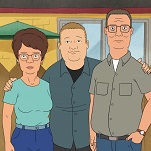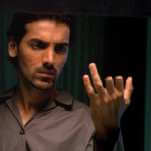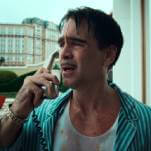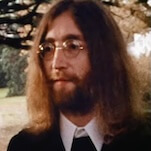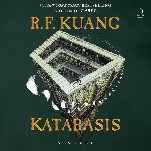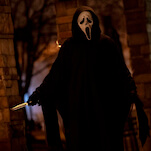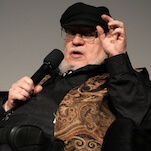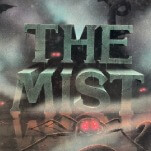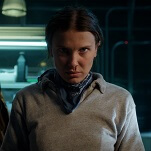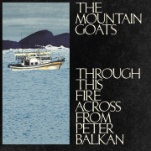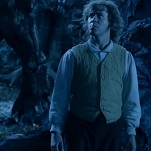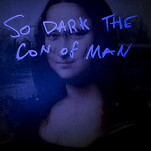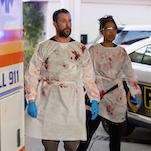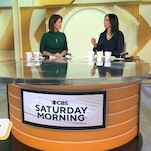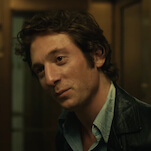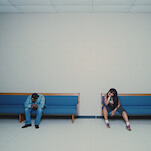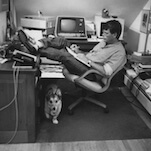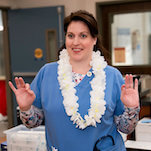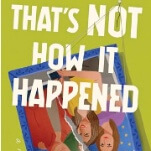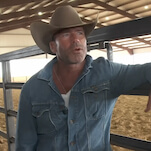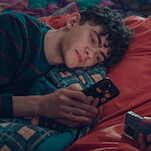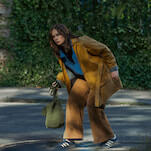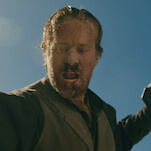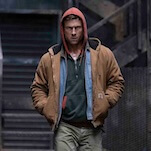Moore’s depiction of Rick and company in the first issues was problematic. Everything looks great—too great, in fact. Even with stubble, Rick’s skin was silky-smooth under Moore’s pen, and his looks of fear were always a bit over-the-top. It actually reminded me a bit of the Avengers comics from the ’60s I used to collect as a teen, which is not really what Kirkman is going for.
Adlard goes for the grit, and it pays dividends. One of the first things I noticed when starting #7 was how haggard Rick is. He already looks like a broken man before Carl’s accident sends him to the brink. I think the last full-page panel of issue #12 proves that the artist switch was a good aesthetic choice as well as a practical one. Rick looks like holy hell, even as he says, “We’re home,” in a presumably cheerful voice. The rendering of his face, blemished and haggard, undercuts that optimism, don’t you think?
I said in the last installment that it was odd starting over with this series and going back to when characters like Rick and Carl seemed so much younger and more open and innocent. Part of that is the writing, but part of it was revisiting Moore’s more cartoony drawing style—as you said, it’s smoother, but the characters are also less realistic. When Moore draws Rick’s face, it’s longer and narrower; the facial expressions are more exaggerated, and people are more stylized in general. Moore uses a lot of soft shades of grey and a variety of line weights; Adlard relies much more on heavy black shadows, and otherwise sticks to more fine, unvaried linework. It makes his work look more dramatic than Moore’s by a fair bit.
Sometimes that backfires. In the first few pages here, when Lori’s having her flashback and her brooding moment, the streaky light and glowing, backlit city as well as Lori’s perpetually windblown hair all said “romance-novel cover” to me more than anything else. There are some odd choices in those first few pages: Notice how over 17 panels, Shane’s eyes are only visible once? And the blobby white space that keeps appearing around the characters so they’ll stand out from the black backgrounds? It all ups the drama level, but in a way that struck me as initially pretty silly and overwrought. (And reminiscent of this Calvin And Hobbes strip, where the usual cartoon style gives way to a deliberately melodramatic look.) Am I alone in that?
Interestingly, Adlard doesn’t make the same mistake when Lori reveals she’s pregnant. There’s an obvious contrast between this scene and the one that opens issue #6, and Lori’s reactions to Rick and Shane are worth us talking through, but did you notice how Adlard manages to put to good use a lot of the tricks that annoyed you in the first section? I’m thinking about the blobby white space and obscured faces in particular. When Lori tells Rick she’s going to have a child, her face becomes more and more shadowed, while Rick’s is only ever partially covered. Lori resembles how she looked in her scene with Shane, but we get Rick’s shocked face in full view. Likewise, there’s the same blobby backlighting, but it’s clearly the plume of the fire they’ve made, which grounds the scene instead of making it overwrought. I’m not sure if I like this “Lori’s pregnant” storyline, but at least this gets the needed gravitas without going overboard. What do you think of the whole baby drama, anyway?
Tasha: My two biggest gripes with The Walking Dead as a whole are the repetition (meet new group, find new place, zombie invasion kills a bunch of people, flee, rinse, repeat) and the soap-opera plotlines. When they aren’t focused on survival, they tend to be much too focused for my tastes on who’s screwing, who’s hung up on someone they aren’t screwing, who’s wishing they’d never screwed, and so on. “I’m pregnant and I don’t know who the father is” drama just makes me roll my eyes and think of Jerry Springer. I don’t care who the baby-daddy is; does it really matter at this point, given everything else the protagonists need to worry about?
That said, I really like your observation here about the reveal scene. You’re right, it’s pretty telling, and pretty adept, how Lori falls into darkness as she explains, while Rick comes into the light. But I was more taken by the storytelling on the following pages, as Rick and Lori tell the group about the baby, and are met with a panel of complete silence, followed by a lone “Um… wow. I just—I don’t know what to say.” Rick’s acerbic response—“‘Congratulations’ has worked for years”—indicates that the small-town Boy Scout hasn’t been entirely scared out of him; even if he isn’t entirely excited about an unplanned baby that isn’t necessarily his, he still expects everyone else to politely pretend enthusiasm. And I notice that once he and Dale start their conversation about the baby’s father, it’s Rick’s face that starts falling into dramatic shadow. Clearly I’m going to have to keep a closer eye on how Adlard uses darkness.
Here’s a little sideline for you, though—the “Um… wow” guy is Donna’s husband Allen, but I had to flip back to book one to verify that, because I initially had no idea who he was. My main gripe with Adlard’s more realistic but less cartoony art is that I sometimes have trouble distinguishing between the characters, especially whenever Rick’s group abruptly expands. Even though they’re designed distinctively, with clear physical identifiers, they sometimes blur together for me. Did you have that problem at all here, especially once we hit the farm and abruptly get a whole wave of new people?
Noah: Completely. I had to go back to the first couple of issues to remember who the hell Carol was when she started flirting with Tyreese. Because she has short blonde hair, like Donna, and kind of looks like Andrea, I completely forgot she was a separate character. Likewise for Hershel’s daughters. (There were two, right?) I hate to harp on Kirkman’s lack of characterization again, but I think that’s ultimately the reason I can’t tell people apart, instead of Adlard’s art. I felt pretty comfortable distinguishing between people after these six issues, mostly because he finally had room to give everyone their own storyline.
Speaking of Donna and Allen, did you feel like she changed her tune pretty drastically from issues #1-6 to now? She was kind of a closed-minded bitch, but suddenly is totally cool with seeing Andrea and Dale getting it on. I know Kirkman has Allen say, “The ice queen melteth” as some sort of commentary on this, but it still felt kind of abrupt to me.
Donna’s discovery of Dale and Andrea gets back to your earlier point, though, with Kirkman’s focus on who’s getting some action. There seemed to be a montage of people getting cuddly in the dark here, and I’m not sure what it did for the story. That being said, if I was stuck in a zombie apocalypse, I’d probably want to get laid any chance I could, even with a dad like Tyreese telling me to keep it in my pants. Which of the newly formed couples worked for you, though?
Tasha: Well, not Glenn and Maggie, who become a couple over a casual “If that’s what you’re after, I’ll fuck you.” And not Carol and Tyreese, who haven’t really become people for me yet. Both of those groupings seem far more abrupt and arbitrary to me than Donna’s melting—which I’ll get to in a minute. Andrea and Dale seems unlikely to me—he’s old enough to be her dad, no?—but people do weird things under the influence of stress and grief. At this point, I’m most interested in Tyreese’s daughter Julie and her boyfriend Chris, who are repeatedly seen here scheming on the side. They come into the story with their own as-yet-unrevealed agenda and mystery, which is something Kirkman doesn’t do enough of this early in the story; for every complicated, specific new character like the farmer Herschel, there are a handful of warm hunks of zombie-fodder like the rest of the farm-dwellers: Lacey, Arnold, Maggie, Billy, Rachel, Susie, Otis, and Patricia. Do any of these guys remotely stand out for you as having personalities?
As to Donna, her stance isn’t that much of a reversal: She does emphasize that she doesn’t approve of Andrea and Dale getting together, and it seems like her objection in the first place was the harem-like setup of him in his camper with two women, so now that we’re down to a more conventional pairing, I’m willing to accept that she’s momentarily just okay with seeing someone happy. I’m also fairly amused by Adlard’s depiction of Dale and Andrea in bed, which is a not-very-sexy mass of pudge, body hair, entwined limbs, and protruding tongues. As much as the series focuses on who’s zoomin’ who, it tends to keep sex not as a titillating, cover-art-inspiring, issue-selling event so much as a contract that comforts two people while not offering much to the rest of the world.
Speaking of comfort, though, I feel pretty strongly that the best part of this arc by far has nothing to do with the art change or the coupling-up or anything else we’ve talked about: It’s the central conversation between Rick and Herschel about the penned-up zombies in the barn. This is something I haven’t seen enough of in zombie stories: Characters stepping outside the wish-fulfillment aspects of zombie stories and dealing with the moral and emotional issues of killing what used to be their friends and families. What did you think of that big confrontation?
Noah: I liked it, because neither Rick nor Herschel is particularly cogent or likeable. Like in the first issues, we have diametrically opposed positions on a disaster, and again, we don’t have a clear winner by the end of it. Most readers are going to immediately side with Rick, but I think that’s related to your point that Herschel’s side is rarely discussed in zombie fiction. We take for granted that zombies can’t be “cured”—even in 28 Days Later, where the zombification is actually a disease, there’s no way to turn back the process—but why not? Why is that our first assumption? I think it’s because every zombie story assumes there’s no cure. And we, as readers, make that same assumption until now. We haven’t seen anything yet to definitively prove Herschel wrong, and Kirkman is reminding us of that here.
But even if Rick is right, he’s a complete dick about it. He still doesn’t seem to have grasped Conflict Resolution 101 (something I’m not sure he’ll ever learn), and he matches Herschel’s crazy from the get-go. Yelling at people rarely convinces them of anything, and his patronizing apology doesn’t help his cause.
But Rick is completely right to be afraid of a bunch of zombies just chilling 30 feet away from him. Herschel is making the mother of all bad decisions here, grasping at unsubstantiated hope because he wants his son to come back. His desperation is not all that different from Rick’s when Carl is shot, though. In some ways, Herschel seems like the extension of Rick, or an example of what might have happened to Rick if Carl had died. Do you see that connection, or does Herschel and Rick’s conflict come across differently for you?
Tasha: I hadn’t thought of that, and it just makes Rick come across as more of an ass, as far as I’m concerned. Let me be clear about this: I’m on Herschel’s side all the way in this book. He takes in strangers with a wounded child, and they eat his food, screw his daughter (oh, the farmer’s-daughter jokes), shoot up his neighbor’s house, demand better lodgings, order him to kill what he thinks of as his sick son… No wonder he throws them out, and more power to him. There isn’t a moment in this book where I think he’s wrong and Rick is right, even when it comes down to the barn full of zombies. At least Herschel is trying to do what he sees as the humane thing. That said, I’m glad neither one of them were directly at fault when the zombie breakout happened. Did the end result affect your opinion of their argument, in terms of the morality of killing zombies out of hand?
Noah: It didn’t, mostly because I saw the barn breakout as a given. Where else was that story going to go? It might have been more effective—and ultimately creepier—if Rick and company had just gone on their way, leaving Herschel with his barn still full of zombies. That isn’t particularly action-packed, though, so I’m not surprised Kirkman went for the “surprise” attack.
I also think Herschel is totally justified in kicking them out, though I’m less inclined to see his use of the barn as “humane.” To me it seems more like an act of desperation, of hiding a problem in the hopes that it will go away. It’s odd to think of something being out of sight, out of mind, when it’s in a barn 30 feet from your house, but Herschel can effectively ignore the loss of his child by keeping his reanimated corpse close. It’s like keeping him on life support when there’s no indication he’ll ever get better. Of course, in the real world, we have plenty of arguments over stuff like this, so Herschel has a leg to stand on here, but I think Herschel’s confrontation with his dead son later on shows that up until that point he really hadn’t grasped what was happening. Or do you think it’s simpler than that?
Tasha: Oh, I think he’s in deep and serious denial. And let me clarify that I don’t think keeping the zombies around is a good thing. But Herschel does, and I empathize with his moral stance. And I think the conversation he and Rick have—both of them instantly furious and shouting, in one of those abrupt emotional explosions that seem to annoy series detractors a lot—is the most interesting thing that happens in this book, because it asks us to question the basis for a lot of zombie hackathons, and consider just for a moment whether zombie-story protagonists are committing mass murder. Granted, that’s a hard argument to take seriously when the zombies are so visibly rotting corpses with body parts falling off every whichaway, and I don’t think we’re expected to buy into Herschel’s point of view. I just respect that he’s actually holding onto his humanity, in a series that’s obsessed with people losing theirs.
I really like your notion that this storyline would have been spookier if Rick and company had gone on and left Herschel there with his barn full of monsters. For me, his casual, unsuspecting line, “We’re keeping them in the barn until we can figure out a way to help them. What have you been doing with them?” is the scariest thing in this story, because it’s one of those moments right before two people who considered each other reasonable suddenly realize there’s a fundamental, irresolvable gulf between them. But it would have been scarier to walk away leaving that gulf hauntingly untouched and uncrossed, rather than proving Rick right with the breakout. Anything else you wish you’d seen in this book?
Noah: I wish one of the characters had thought to start learning about farming from Herschel, which goes back to our talk before about how Rick and company are awful guests. I don’t think this is a problem on Kirkman’s part, since he obviously wants his characters to keep making things worse for themselves, but it’s a little heartrending to see them have the chance to gain a little knowledge, only to completely ignore it. Instead of getting Herschel to tell them about cultivating crops, keeping livestock, etc. Rick instead decides to keep up with shooting practice—which we know attracts zombies. They’re totally content to profit off Herschel’s labor, and nothing else. I wouldn’t want three pages of “How To Farm by Herschel,” which would be incredibly boring, but I’m rooting for these guys enough that I’d like them to start planning ahead.
I want to throw Tasha’s question out to everyone else here, and get the conversation started. What do you wish you’d seen in issues #7-12?
Also, I know some people last week wanted to talk about Moore vs. Adlard, and had completely different opinions about the changeover than ours. Do you think the transition works, or was Moore the better choice?
